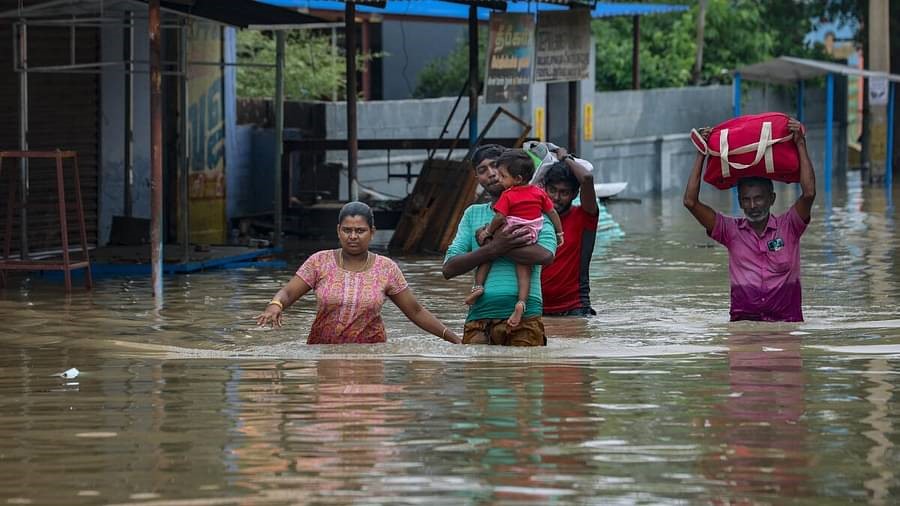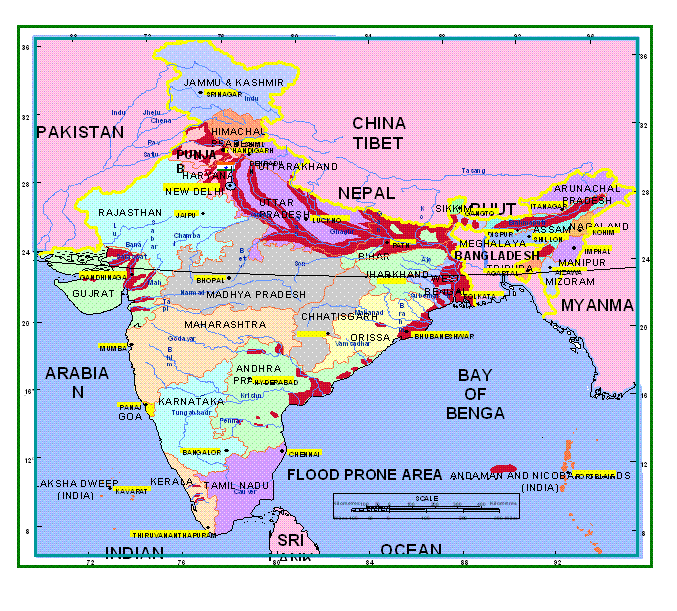Description

Disclaimer: Copyright infringement not intended.
Context
The Cabinet has given the nod to the continuation of the Flood Management and Border Areas Programme (FMBAP), which aims to address critical aspects of flood control and anti-erosion measures,for the period spanning 2021-2026.
Details
- The Union Cabinet chaired by Prime Minister approved the proposal of Department of Water Resources, RD & GR for continuation of centrally sponsored Scheme, “Flood Management and Border Areas Programme (FMBAP)” with total outlay of Rs. 4,100 crore for a period of 5 years from 2021-22 to 2025-26 (15th Finance Commission period).
Two components
Flood Management Programme (FMP)
- Under the Flood Management Programme (FMP) component of FMBAP with an outlay of Rs. 2940 crore, central assistance will be provided to State Governments for taking up critical works related to flood control, anti-erosion, drainage development and anti-sea erosion, etc.
- The pattern of funding to be followed is 90% (Centre): 10% (State) for Special Category States (8 North-Easter States and Hilly States of Himachal Pradesh, Uttarakhand and UT of Jammu & Kashmir) and 60% (Centre):40% (State) for General/ Non-Special Category States.

River Management and Border Areas (RMBA)
- Under River Management and Border Areas (RMBA) component of FMBAP with an outlay of Rs. 1160 crore, flood control and anti-erosion works on common border rivers with neighbouring countries including hydrological observations and flood forecasting, and investigation & pre-construction activities of joint water resources projects (with neighbouring countries) on common border rivers will be taken up with 100% central assistance.
Addressing the Impact of Climate Change
- The decision to continue the FMBAP underscores the government's proactive approach to addressing the challenges posed by climate change.
- The increased incidence of extreme weather events in recent years has highlighted the urgent need for robust flood management strategies.
- The FMBAP will play a crucial role in mitigating the impact of climate change by promoting the adoption of modern technology and encouraging states to enhance their flood management capabilities.
Flood Prone Areas in India

Statutory Provisions about Flood Management
- The subject of flood control, unlike irrigation, does not figure as such in any of the three legislative lists included in the Constitution State list,Union list and concurrence list of India.
- However, Drainage and Embankments, are two of the measures specifically mentioned in entry 17 of List II (State List).
- Water, that is to say, water supplies, irrigation and canals, drainage and embankments, water storage and water power subject to the provision of entry 56 of List I(Union List).
- Entry 56 of List I (Union List): Regulation and development of inter-State rivers and river valleys to the extent to which such regulation and development under the control of the Union is declared by Parliament by law to be expedient in the public interest..”
- It may thus be seen that the primary responsibility for flood control lies with the States. A number of States have already enacted laws with provisions to deal with matters connected with flood control works. Therefore, the subject “ flood management” falls within the purview of the States.
- The schemes for flood control are planned, investigated and implemented by the States as per priorities within the State with their own resources and the role of central government is technical, advisory, catalytic and promotional in nature.
Existing Flood Management Mechanisms in India
In India, a two tier system of flood management exists:
- State Level Mechanism - The State Level Mechanism includes the Water Resources Departments, State Technical Advisory Committee and Flood Control Board. In some States, the Irrigation Departments and Public Works Departments look after flood matters.
- Central Government Mechanism – The Union Government has set up following organizations and various expert committees to enable the State Governments in addressing flood problems in a comprehensive manner:
Central Water Commission (CWC)
- The Government of India set up Central Water Commission as presently named in 1945 for achieving the goal of furthering and promoting measures of flood control, conservation and utilization of water resources through out the country in the areas of beneficial uses, irrigation and hydropower generation, flood management and river conservation.
- As a national apex engineering organisation in the field of water resources development, the CWC with its vast experience gained in its strides towards progress in more than six decades, has developed considerable know-how in planning, investigation, management and design of water resources development schemes and made valuable contribution in the country’s remarkable progress in this field besides sharing the expertise with developing nations of the world.
Brahmaputra Board
- The Government of India set up Brahmaputra Board under Brahmaputra Board Act, 1980 (46 of 1980) under the then Ministry of Irrigation ( now Ministry of Jal Shakti) The jurisdiction of Brahmaputra Board includes all NE States in Brahmaputra and Barak Basin.
- Brahmaputra Board prepared master plans for the flood management for river Brahmaputra and Barak.Besides this, the Board has undertaken survey and investigations for preparation of master plans for tackling the problems of flood, erosion and drainage congestion including DPRs for multipurpose projects.
Ganga Flood Control Commission
- The Ganga Flood Control Commission (GFCC) was set up by Government of India in 1972 for preparation of comprehensive plan of flood control for Ganga Basin and to draw out a phased coordinated programme of implementation of works and monitoring & appraisal of flood management schemes of Ganga basin States.
- The GFCC has prepared comprehensive plans of flood management of the 23 sub-basins in the Ganga Basin besides drawing out a phased programme of implementation of these works to proper standards, examination and monitoring of various flood management schemes in the Ganga Basin States.
Farakka Barrage Project Authority
- The Farakka Barrage Project Authority carry out anti-erosion and river bank protection works in its jurisdiction in near river vicinity of the Barrage..
National Disaster Management Authority (NDMA)
- For prevention and mitigation effects of disasters including flood disasters and for undertaking a holistic, coordinated and prompt response to any disaster situation, the Government of India has set up a National Disaster Management Authority (NDMA) in 2005 under the Chairmanship of Hon’ble Prime Minister of India.
General Flood Management Measures practiced in India
Engineering / Structural Measures:
- An artificially created reservoir behind a dam across a river.
- A natural depression suitably improved and regulated, if necessary.
- By diversion of a part of the peak flow to another river or basin, where such diversion would not cause appreciable damage.
- By constructing a parallel channel bye passing a particular town/reach of the river prone to flooding.
- Embankments that artificially raise the effective river bank and thereby prevent spilling.
- Channel and drainage improvement works, which artificially reduce the flood water level so as to keep the same, confined within the river banks and thus prevent spilling.

Administrative / Non-Structural Measures:
- Facilitating timely evacuation of the people and shifting of their movable property to safer grounds by having advance warning of incoming flood, i.e. flood forecasting, flood warning in case of threatened inundation.
- Discouraging the creation of valuable assets/settlement of the people in the areas subject to frequent flooding, i.e. enforcing flood plain zoning regulation.
Conclusion
The continuation of the Flood Management and Border Areas Programme is a testament to the government's commitment to safeguarding the lives and livelihoods of citizens in flood-prone areas. By providing substantial financial assistance and promoting innovative approaches, the FMBAP will empower states to effectively manage flood risks and build resilient communities.
|
PRACTICE QUESTIONS
Discuss the challenges and strategies for effective flood management in India, considering the socio-economic and environmental implications. 200 words
|















